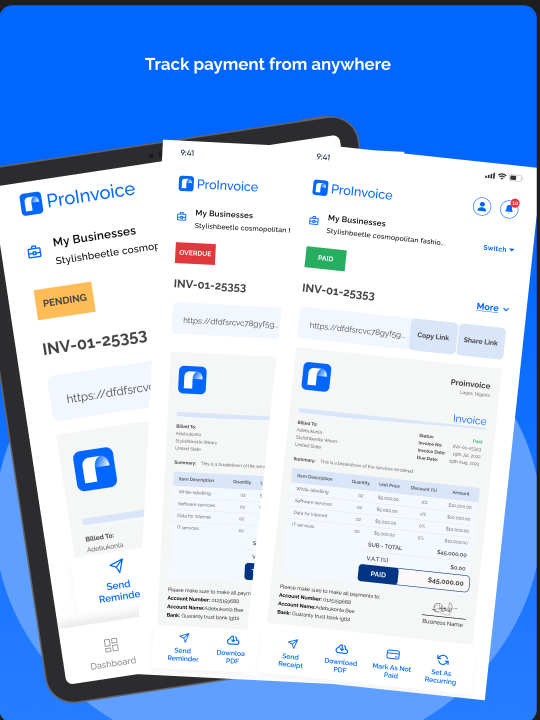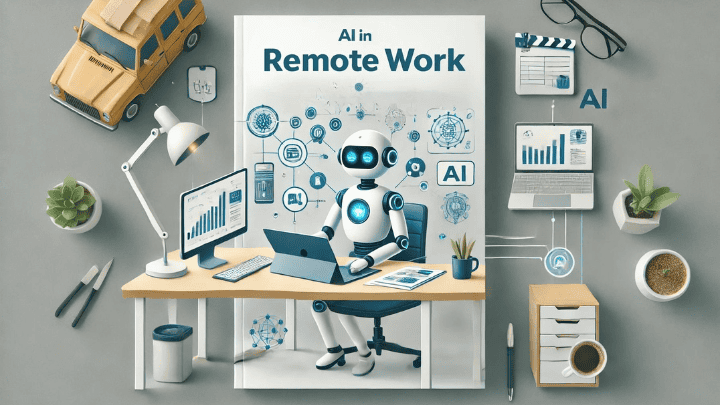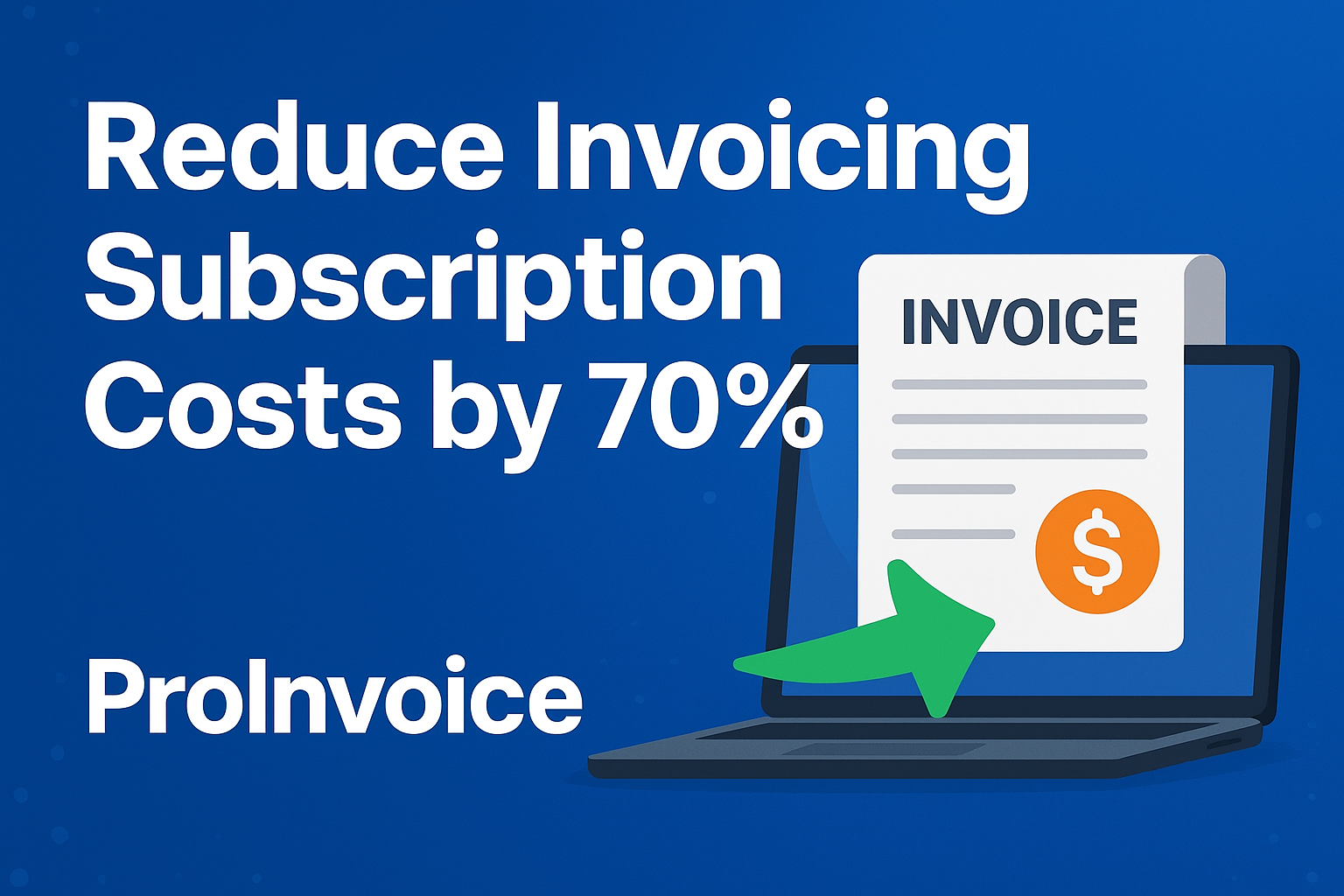The remote work landscape has fundamentally transformed how we approach productivity, collaboration, and business operations. As we navigate through 2025, artificial intelligence has emerged as the game-changing force that’s revolutionizing how remote workers and businesses operate. From automated invoice generation to intelligent project management, the AI Productivity Tools for Remote Work in 2025 are no longer luxury additions but essential components of successful remote work strategies.
The statistics speak volumes about this transformation. Remote work has increased by over 200% since 2020, and companies utilizing AI productivity tools report 40% higher efficiency rates compared to traditional methods. This comprehensive guide explores the most impactful AI tools that are reshaping remote work productivity, helping businesses streamline operations, reduce manual tasks, and focus on what truly matters: growth and innovation.
Understanding the Revolution of AI
Artificial intelligence in the workplace is not just about machines replacing humans. It’s about enhancing human capabilities and removing time-consuming, repetitive tasks. For remote workers, AI transforms how we manage everything from client communication to financial operations.
Enhancing Human Efficiency
AI tools allow individuals to complete tasks that previously needed entire teams. Freelancers, small business owners, and distributed teams can now use these tools to solve unique operational challenges more efficiently.
The secret to successful AI integration lies in tool selection. Identify tools that address your specific needs—whether it’s streamlining communication, managing projects, or automating admin tasks. This ensures that AI becomes a helpful ally, not just another layer of complexity.
Learning and Adapting to You
A major advantage of AI tools is their adaptability. Over time, they learn your work patterns and preferences. This means they not only assist but also anticipate your needs, improving workflows without constant manual input.
As a result, remote workers can stay focused on high-value tasks, knowing that AI is handling routine responsibilities in the background. This adaptability is especially crucial in dynamic work environments where flexibility is key.
Essential AI Writing and Communication Tools
Communication forms the backbone of successful remote work, and AI-powered writing tools have revolutionized how we create, edit, and optimize content. These tools go beyond simple grammar checking to provide intelligent suggestions for tone, structure, and engagement.
Grammarly Business has evolved into a comprehensive writing assistant that not only corrects grammar but also provides tone suggestions, plagiarism detection, and style improvements. For remote teams, this ensures consistent communication quality across all team members, regardless of their native language or writing experience. The tool integrates seamlessly with popular platforms like Slack, Gmail, and Google Docs.
Jasper AI has become the go-to solution for content creation, offering templates for everything from email responses to marketing copy. Remote workers can leverage Jasper to create professional client communications, social media posts, and even technical documentation. The tool’s ability to maintain brand voice consistency makes it invaluable for businesses managing multiple client relationships.
Copy.ai specializes in generating marketing and sales content, making it perfect for remote entrepreneurs and small business owners. The platform offers templates for product descriptions, social media captions, and email campaigns. When combined with proper invoice management systems, these tools create a complete business communication ecosystem.
Notion AI has transformed the popular workspace platform into an intelligent content creation hub. Remote teams can use Notion AI to generate meeting summaries, create project briefs, and even draft policy documents. The integration with Notion’s existing database and project management features makes it a powerful all-in-one solution.
The key to maximizing these tools lies in understanding their strengths and limitations. While AI can generate impressive content quickly, human oversight remains crucial for ensuring accuracy, relevance, and brand alignment. The most successful remote workers use these tools as intelligent assistants rather than replacements for human creativity and judgment.

Proinvoice makes invoicing effortless. Use custom templates, automate reminders, set recurring bills, and track everything from one smart dashboard. Get paid faster — with less hassle.
Project Management and Organization AI
Project management in remote environments requires tools that can handle complex workflows, team coordination, and deadline tracking without constant manual intervention. AI-powered project management platforms have emerged as essential solutions for remote teams of all sizes.
Monday.com’s AI features include automated task assignment, project timeline optimization, and workload balancing. The platform’s machine learning algorithms analyze team performance patterns and suggest optimal task distributions. This is particularly valuable for remote teams where managers can’t physically observe workload distribution.
Asana Intelligence provides smart project insights, automated routine task creation, and deadline risk assessment. The AI analyzes project patterns to predict potential bottlenecks and suggests preventive measures. Remote teams benefit from these predictive capabilities, as they help prevent the communication delays that often plague distributed work environments.
ClickUp’s AI assistant can generate project briefs, create task dependencies, and even suggest team member assignments based on skills and availability. The platform’s ability to integrate with time tracking and billing systems makes it particularly valuable for service-based businesses that need to maintain accurate client billing records.
Trello’s Butler automation engine uses AI to create custom workflows that respond to specific triggers. Remote teams can set up automated card movements, deadline reminders, and status updates that keep projects moving without constant manual intervention. This automation is crucial for maintaining momentum in asynchronous work environments.
The integration capabilities of these platforms extend beyond project management to encompass entire business workflows. When connected with financial management tools and automated billing solutions, these systems create comprehensive business management ecosystems that require minimal manual oversight.
Related: The USA’s Digital Roadmap for SMEs
AI-Powered Financial and Administrative Tools
Remote work often means wearing multiple hats, especially for entrepreneurs and small business owners who must handle administrative tasks alongside their core business activities. AI-powered financial and administrative tools have become essential for maintaining professional operations without dedicated support staff.
QuickBooks AI features automated expense categorization, receipt scanning, and financial forecasting. The system learns from your business patterns to provide increasingly accurate financial insights and automate routine bookkeeping tasks. For remote workers managing multiple income streams, this automation is invaluable for maintaining accurate financial records.
Xero’s AI capabilities include smart invoice matching, automated bank reconciliation, and cash flow forecasting. The platform’s machine learning algorithms can predict payment patterns and identify potential cash flow issues before they become problems. This predictive capability is crucial for remote businesses that need to maintain stable operations without constant financial monitoring.
Receipt organization and expense tracking have been revolutionized by AI tools like Expensify and Receipt Bank. These platforms can automatically extract data from receipts, categorize expenses, and integrate with accounting systems. For remote workers who often handle business expenses personally, this automation eliminates hours of manual data entry.
Invoice management represents one of the most time-consuming administrative tasks for remote businesses. Modern AI-powered solutions can automatically generate professional invoices, track payment status, and send follow-up reminders. The integration of these systems with project management tools creates seamless billing workflows that require minimal manual intervention.
The compound effect of automating these administrative tasks cannot be overstated. Remote workers who effectively implement AI-powered financial tools often report saving 10-15 hours per week on administrative tasks, time that can be redirected toward revenue-generating activities and business growth.
Customer Relationship Management AI Productivity Tools for Remote Work in 2025
Maintaining strong customer relationships while working remotely requires sophisticated systems that can track interactions, automate follow-ups, and provide insights into customer behavior. AI-powered CRM systems have become essential tools for remote sales teams and customer service operations.
HubSpot’s AI features include predictive lead scoring, automated email sequences, and customer behavior analysis. The platform’s machine learning algorithms can identify the most promising leads and suggest optimal contact strategies. For remote sales teams, this intelligence is crucial for prioritizing efforts and maximizing conversion rates.
Salesforce Einstein provides advanced analytics, predictive forecasting, and automated data entry. The AI can analyze customer interaction patterns to suggest the best times for outreach and predict which deals are most likely to close. Remote sales professionals can leverage these insights to optimize their daily activities and focus on high-value opportunities.
Pipedrive’s AI assistant helps with deal probability assessment, next action suggestions, and sales pipeline optimization. The system learns from successful sales patterns to provide personalized recommendations for each opportunity. This guidance is particularly valuable for remote workers who don’t have immediate access to mentorship and team collaboration.
Customer service automation through AI chatbots and response systems has become essential for remote businesses. Tools like Intercom and Zendesk AI can handle routine customer inquiries, escalate complex issues to human agents, and provide 24/7 support coverage. This automation is crucial for remote businesses that need to maintain professional customer service standards without large support teams.
The integration of CRM systems with other business tools creates powerful automation workflows. When connected with project management platforms and billing systems, these tools can automatically create project records from sales opportunities, track project progress, and generate accurate invoices based on completed work.
Automation and Workflow Optimization for AI Productivity Tools for Remote Work in 2025
The true power of AI productivity tools emerges when they’re connected through automation platforms that can orchestrate complex workflows across multiple systems. These integrations eliminate manual handoffs and ensure information flows seamlessly between different business functions.
Zapier has become the central nervous system for many remote operations, connecting thousands of apps through AI-powered automation. The platform’s AI can suggest workflow optimizations based on usage patterns and automatically create complex multi-step processes. Remote teams can use Zapier to connect their project management, communication, billing, and customer service tools into unified workflows.
Microsoft Power Automate provides enterprise-level workflow automation with deep integration into the Microsoft ecosystem. The AI capabilities include document processing, data extraction, and intelligent routing of information between systems. For remote teams already using Microsoft tools, Power Automate can dramatically reduce manual administrative tasks.
IFTTT (If This Then That) offers simple but powerful automation for personal productivity and small business operations. The platform’s AI can learn from your automation patterns and suggest new workflows that might improve efficiency. Remote workers can use IFTTT to automate social media posting, file organization, and communication workflows.
Notion’s database automation features allow remote teams to create intelligent information systems that automatically categorize, tag, and route information based on content analysis. This capability is particularly valuable for knowledge work where information organization and retrieval are critical for productivity.
The strategic implementation of workflow automation requires careful planning and gradual implementation. Successful remote workers start with simple automations and gradually build more complex workflows as they understand how different tools interact. The goal is to create systems that work reliably in the background, reducing cognitive load and freeing mental energy for creative and strategic work.
AI Tools for Content Creation and Marketing
Remote businesses often struggle with consistent content creation and marketing due to limited resources and time constraints. AI-powered content tools have democratized high-quality marketing, enabling small remote operations to compete with larger organizations.
Canva’s AI design features can automatically generate social media graphics, presentations, and marketing materials based on text prompts. The Magic Design feature creates multiple design options instantly, allowing remote workers to maintain professional visual branding without design expertise. The platform’s template suggestions learn from industry trends and user preferences.
Loom’s AI-powered video features include automatic transcription, summary generation, and key moment identification. Remote teams can use these capabilities to create training materials, client presentations, and internal communications more efficiently. The AI summaries are particularly valuable for asynchronous communication, allowing team members to quickly understand video content without watching entire recordings.
Buffer’s AI assistant helps optimize social media posting schedules, suggests content improvements, and analyzes engagement patterns. Remote businesses can use these insights to maintain consistent social media presence without dedicated marketing staff. The tool’s ability to suggest optimal posting times based on audience behavior is crucial for maximizing reach and engagement.
Content research and SEO optimization have been streamlined through AI tools like Surfer SEO and SEMrush. These platforms provide AI-driven content briefs, keyword suggestions, and optimization recommendations. Remote content creators can use these tools to ensure their content ranks well in search results while providing genuine value to readers.
The content creation workflow becomes exponentially more efficient when these tools are integrated with business management systems. Remote entrepreneurs who connect their content planning with project timelines and client deliverables create sustainable content operations that support long-term business growth.
Time Management and Productivity Analytics for AI Productivity Tools for Remote Work in 2025
Understanding and optimizing how time is spent becomes crucial in remote work environments where traditional supervision methods don’t apply. AI-powered time management tools provide insights and automation that help remote workers maximize their productive hours.
RescueTime’s AI analytics provide detailed insights into digital behavior patterns, identifying productivity trends and time-wasting activities. The platform’s AI can automatically categorize activities and provide personalized recommendations for improving focus and efficiency. Remote workers can use these insights to optimize their daily schedules and identify their most productive working hours.
Toggl Track’s AI features include automatic time tracking suggestions, project time estimation, and productivity reporting. The system learns from historical data to provide increasingly accurate project estimates and identify potential scheduling conflicts. This capability is essential for remote workers who bill clients hourly or need to manage multiple project deadlines.
Forest App uses gamification and AI to help remote workers maintain focus during deep work sessions. The AI analyzes focus patterns and suggests optimal work session lengths based on individual productivity rhythms. This personalized approach helps remote workers develop sustainable productivity habits.
Calendar AI tools like Calendly and Reclaim.ai use machine learning to optimize meeting scheduling and protect focus time. These systems can automatically schedule meetings at optimal times, block focus periods, and even reschedule conflicting appointments. For remote workers managing multiple client relationships, this automation prevents double-booking and ensures adequate time for deep work.
The key to effective time management with AI tools lies in consistent data collection and regular review of insights. Remote workers who actively engage with their productivity data and adjust their workflows based on AI recommendations typically see 25-30% improvements in time efficiency within the first few months of implementation.
Integration Strategies for Maximum Efficiency
The real productivity gains from AI tools come not from individual applications but from thoughtful integration that creates seamless workflows across all business functions. Successful remote workers develop integration strategies that minimize context switching and maximize automation.
Data flow optimization involves ensuring that information entered once automatically populates across all relevant systems. For example, when a new client is added to a CRM system, this information should automatically create project folders, set up communication channels, and prepare billing templates. This level of integration prevents data inconsistencies and reduces administrative overhead.
Notification management becomes crucial when multiple AI tools are working simultaneously. The most effective remote workers configure their tools to provide summary notifications rather than real-time alerts for non-urgent items. This approach maintains awareness without constant interruption, preserving focus for deep work while ensuring important items aren’t missed.
Backup and redundancy planning ensures that AI-powered workflows remain functional even when individual tools experience issues. Remote workers should understand the dependencies between their tools and have manual processes ready when automation fails. This preparation prevents productivity disruptions and maintains professional client relationships.
Regular workflow auditing involves reviewing automation effectiveness and identifying optimization opportunities. AI tools generate significant amounts of data about workflow performance, and remote workers who regularly analyze this information can identify bottlenecks and improvement opportunities that might not be obvious during daily operations.
The financial aspect of tool integration often determines long-term sustainability. Remote workers need to balance the cost of multiple AI subscriptions with the productivity gains and revenue impact. Tools that integrate well with existing systems often provide better return on investment than powerful standalone solutions that require significant workflow changes.
Security and Privacy Considerations
Remote work environments require heightened attention to security and privacy, especially when AI tools are processing sensitive business information. Understanding and managing these risks is essential for maintaining client trust and regulatory compliance.
Data encryption and storage policies vary significantly between AI platforms. Remote workers should prioritize tools that offer end-to-end encryption, comply with relevant privacy regulations, and provide clear data retention policies. This is particularly important for businesses handling client financial information or personal data.
Access control and authentication become more complex when multiple AI tools require different login credentials and permissions. Remote workers should implement comprehensive password management and consider single sign-on solutions that provide unified access control across their tool ecosystem.
Regular security audits of AI tools should include reviewing permissions, checking for unauthorized access, and ensuring that integrations maintain appropriate security standards. Remote businesses often overlook these audits, but they’re essential for preventing data breaches and maintaining professional credibility.
Compliance requirements vary by industry and location, but remote workers should understand how their AI tool usage affects regulatory obligations. Tools that automatically generate financial documents or handle customer data may need to meet specific compliance standards that affect tool selection and configuration.
The balance between convenience and security requires ongoing attention. While AI tools can significantly improve productivity, remote workers must ensure that efficiency gains don’t come at the expense of data security or client privacy. The most successful remote operations implement security practices that become automatic parts of daily workflows.
Future-Proofing Your Remote Work Setup
The AI tool landscape evolves rapidly, with new capabilities and platforms emerging regularly. Remote workers who want to maintain competitive advantages need strategies for staying current with technological developments while avoiding constant workflow disruptions.
Tool evaluation frameworks help remote workers assess new AI solutions systematically. This involves defining specific criteria for productivity impact, integration requirements, cost considerations, and learning curve factors. Having clear evaluation criteria prevents impulsive tool adoption that can fragment workflows and reduce overall efficiency.
Scalability planning ensures that AI tool choices can grow with business needs. Remote workers should consider how their chosen tools will perform as team sizes increase, client loads expand, and business complexity grows. Tools that offer flexible pricing and feature scaling provide better long-term value than solutions with rigid limitations.
Skill development in AI tool usage requires ongoing learning and experimentation. The most effective remote workers dedicate time to exploring new features, testing integration possibilities, and staying informed about industry best practices. This investment in learning pays dividends through improved efficiency and competitive positioning.
Community engagement through user forums, professional networks, and industry groups provides valuable insights into tool effectiveness and emerging trends. Remote workers who actively participate in these communities often discover optimization strategies and integration techniques that aren’t documented in official tool documentation.
The strategic approach to AI tool adoption involves gradual implementation with careful measurement of impact. Rather than attempting to revolutionize entire workflows overnight, successful remote workers implement AI tools incrementally, measuring productivity gains and adjusting strategies based on real-world results.
Measuring ROI and Productivity Gains
Understanding the financial impact of AI productivity tools requires systematic measurement and analysis. Remote workers and businesses need frameworks for evaluating whether their tool investments are generating positive returns and driving meaningful productivity improvements.
Time tracking analysis provides the foundation for measuring AI tool effectiveness. By comparing time spent on specific tasks before and after AI implementation, remote workers can quantify productivity gains and identify areas where additional optimization might be beneficial. This analysis should include both direct time savings and indirect benefits like reduced errors and improved quality.
Revenue impact measurement involves tracking how AI tools affect client acquisition, project completion rates, and billing efficiency. For service-based remote businesses, tools that streamline client onboarding, automate routine communications, and ensure accurate billing can significantly impact profitability. The ability to handle more clients with the same resources directly translates to revenue growth.
Cost-benefit analysis should include both direct tool costs and implementation time investment. Remote workers need to factor in learning curves, integration setup time, and ongoing maintenance requirements when evaluating tool effectiveness. The most valuable AI tools provide positive returns within 3-6 months of implementation.
Quality improvements often represent hidden value that traditional productivity metrics miss. AI tools that reduce errors, improve client communication quality, or enhance deliverable standards create long-term business value that may not be immediately apparent in time-tracking data.
Client satisfaction metrics can reveal productivity gains that internal measurements might miss. Remote businesses using AI tools often report improved response times, more consistent service quality, and enhanced professional presentation. These improvements can lead to higher client retention rates and increased referral business.
Advanced Integration Techniques
The most sophisticated remote work operations leverage advanced integration techniques that create truly automated business processes. These implementations require technical knowledge but can dramatically transform operational efficiency.
API connections enable custom integrations between AI tools and existing business systems. Remote workers with technical skills can create automated workflows that move data between platforms, trigger actions based on specific events, and maintain synchronized information across multiple systems. These custom integrations often provide capabilities that aren’t available through standard tool offerings.
Webhook automation allows real-time response to events across different platforms. For example, when a project reaches completion in a project management system, webhooks can automatically generate invoices, send client notifications, and update financial records. This level of automation ensures that business processes continue smoothly even when the remote worker is unavailable.
Custom dashboard creation through tools like Google Data Studio or Tableau can aggregate information from multiple AI platforms into unified reporting interfaces. Remote business owners can create executive dashboards that provide real-time insights into productivity metrics, financial performance, and client satisfaction without manually checking multiple systems.
Data synchronization strategies ensure that information remains consistent across all business systems. This involves establishing data governance policies, implementing validation rules, and creating backup procedures that maintain data integrity even when automated systems encounter errors.
The technical complexity of advanced integrations requires careful planning and often benefits from professional consultation. However, remote workers who successfully implement these systems often achieve productivity levels that would require significantly larger teams using traditional methods.
Building Your AI-Powered Remote Work Strategy
Creating an effective AI-powered remote work strategy requires systematic planning, gradual implementation, and continuous optimization. The most successful remote workers approach AI adoption as a long-term investment in their professional capabilities rather than a quick fix for immediate challenges.
Assessment and planning begin with honest evaluation of current workflows, identification of time-consuming tasks, and clear definition of productivity goals. Remote workers should prioritize AI implementations that address their most significant pain points while building toward comprehensive workflow automation.
Implementation phases should focus on one tool category at a time, allowing adequate time for learning and integration before adding additional complexity. This gradual approach prevents workflow disruption and ensures that each tool is properly optimized before moving to the next implementation phase.
Training and skill development require dedicated time investment but pay significant long-term dividends. Remote workers should allocate regular time for exploring tool features, testing new integrations, and staying current with platform updates. This ongoing learning ensures maximum value from AI tool investments.
Performance monitoring involves regular review of productivity metrics, cost-benefit analysis, and workflow effectiveness. Remote workers should establish monthly review processes that evaluate tool performance and identify optimization opportunities. This systematic approach ensures that AI implementations continue providing value as business needs evolve.
The ultimate goal of AI-powered remote work isn’t just efficiency but sustainable competitive advantage. Remote workers who successfully implement comprehensive AI strategies often find they can deliver higher-quality services, handle larger client loads, and maintain better work-life balance than their traditionally-equipped competitors.
Conclusion: Embracing the AI-Powered Future
The integration of AI productivity tools into remote work operations represents more than a technological upgrade; it’s a fundamental shift toward more intelligent, efficient, and sustainable business practices. As we move further into 2025, the remote workers and businesses that thrive will be those who thoughtfully implement AI solutions that amplify human capabilities rather than simply adding complexity to existing workflows.
The key to success lies in understanding that AI tools are most effective when they’re part of integrated systems that support entire business processes. From initial client contact through project delivery and billing, AI can streamline every aspect of remote operations when properly implemented and maintained.
The investment in AI productivity tools requires both financial resources and time commitment, but the returns justify the effort for most remote operations. The ability to handle larger client loads, reduce administrative overhead, and maintain professional standards without expanding team size provides sustainable competitive advantages in increasingly crowded markets.
Looking ahead, the AI tool landscape will continue evolving rapidly, with new capabilities and integration possibilities emerging regularly. Remote workers who establish strong foundations with current tools while maintaining flexibility for future adaptations will be best positioned to benefit from these ongoing developments.
The future of remote work is undeniably AI-powered, and the organizations that embrace this transformation thoughtfully and strategically will define the standards for professional remote operations in the years to come. The time to begin this transformation is now, starting with careful tool selection and gradual implementation that builds toward comprehensive AI-powered business operations.





![Best AI Invoice Automation Software for Small Business USA [2025]](https://proinvoice.co/wp-content/uploads/2025/08/ProInvoice-AI-Invoice.webp)







